
CellRobot Launching Modular Robots for Futuristic Applications

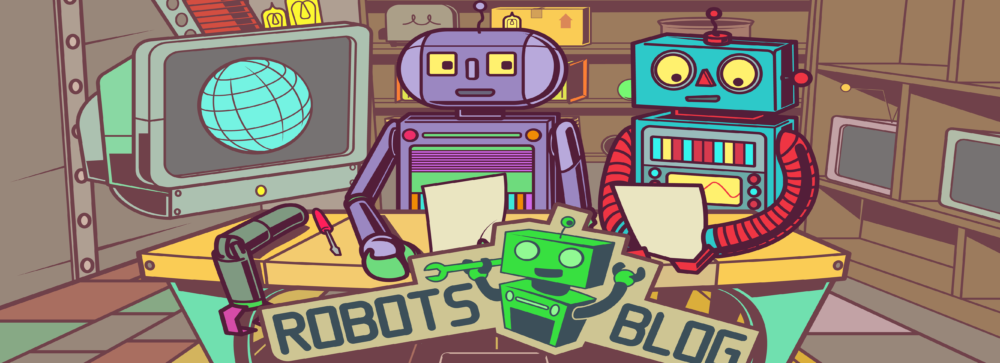

London, UK – Cannybots, the programmable smart toy robots that can be controlled from a smartphone or tablet, and that get kids excited about robotics, today launched on Kickstarter.
Cannybots are smart toy robots that encourage children to play and spend time together, rather than spending their days in front of screens playing virtual games online. Cannybots teaches kids about robotics, programming, design and 3D printing while they are playing.
Children receive a construction kit for their Cannybot containing all the parts and detailed instructions to build their robot. They can then be programmed and controlled from phone, tablet, PC or a Raspberry Pi.
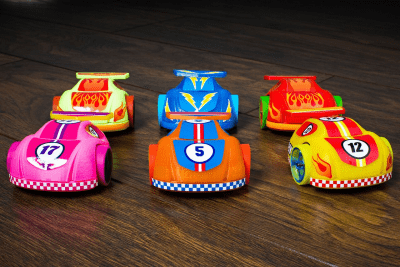
“Going through the building process gives kids the hands-on experience of building a functional robot that they can also program,” said Anish Mampetta, CEO of Cannybots. “Programming is an essential skill today but it is not easy to get kids started. We are allowing kids to do this in a fun, interactive and rewarding way.”
To introduce children to programming, the Cannybots team created a simple and intuitive app called ‘CannyTalk’. The app uses a syntax-free programming environment that works like a friendly chat tool. Using the app anyone can program the Cannybot using plain English. The complex Artificial Intelligence (AI) based engine behind CannyTalk is developed in association with researchers from the Computer Science department at the University of Cambridge in the UK.
“The children use programming to solve puzzles, control Cannybots on race tracks, and create new game play styles,” added Mampetta. “It’s an interactive, social experience that brings friends and family together.”
Once built and programmed, the bots can be used in a number of play scenarios such as high speed racing, time trials, sumo-wrestling, jousting and puzzle-solving. Apps and printable tracks are available for each game. Children can also design new car bodies using free, easy to use, browser based CAD software from Cannybots’ partner Autodesk. The designs can be then easily 3D printed using any home 3D Printer.

The current version of Cannybots is already very popular and is being used in over 20 schools in the UK and Europe.
Pre-orders start as low as $89 for an early bird special and will be shipped in time for the holidays.
For more information visit www.cannybots.com and on their Kickstarter campaign page – www.cannybots.com/kickstarter
About Cannybots
Cannybots are smart toy robots that can be controlled and programmed from a phone or a tablet. This engaging toy brings kids play time out of their tablets and back into the real world. It also introduces kids to Programming, 3D Printing and Robotics through play.
Cannybots can be used in a large number of play scenarios, such as –Racing, Sumo Wrestling, Jousting, Maze solving and other puzzle games. There is a dedicated phone app and track design for each game play. Customer can print the tracks at home or use the large format tracks that we supply. It is also possible to make a large track by printing segments of A4 sheets. The bots work by following black lines and colored mark printed on the track.
Cannybots can be programmed from a Phone or a Tablet using a simple, intuitive app called CannyTalk. It is a Natural Language based programming interface using which you can program the robot in plain simple English. It eliminates the complex Syntax found with other programming languages thus making it easy for kids to get started.
Cannybots designs are open source, free and 3D Printable. You can easily customize the design using free, browser based CAD software from our partner Autodesk. The customized designs can be 3D printed using any ordinary home 3D printer.
San Francisco, September 24, 2015 – Robo Wunderkind is a programmable robotics kit for children of all ages. On Monday, September 21, it was launched on Kickstarter, with early bird pledges starting from just $79. Robo Wunderkind is revolutionizing how coding is taught through robotics. Kids of all ages find it easy and enjoyable to play with!
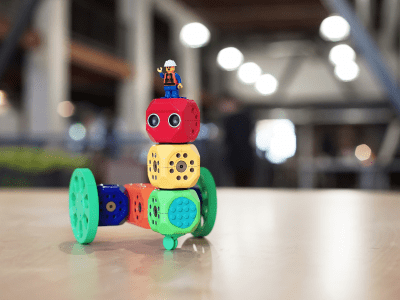
Robo Wunderkind is a set of blocks for building robots. On the outside, Robo blocks are child friendly and safely encase the sophisticated electronics contained on the inside. These electronic components transform regular blocks into programmable robotic components. By just snapping blocks together, even a five year old can build a robot. The fun doesn`t stop there: kids can playfully program the robot in an intuitive app. Modular, colorful, and LEGOTM compatible, this is the toy that opens up children`s eyes to the world of technology.
Kickstarter link: https://www.kickstarter.com/projects/startrobo/robo–wunderkind–a–programmable–robot–for–kids–of–a
Rustem Akishbekov, the founder and CEO of Robo Wunderkind, initially came up with the idea of a child-friendly programmable robot while trying to teach his friends the basic of coding and robotics. When he realized how complicated it was for new-to-programming users, he set out to make learning coding and robotics as fun and simple as playing with LEGOTM.
“We want to revolutionize the toys our kids play with, we want them to be more than pieces of plastic,” explains Rustem Akishbekov. “The LEGOTM brick hasn`t changed over 60 years while everything around it has. Now is the time for a smart toy like Robo Wunderkind that will help kids develop the skills they need for the future.”
Robo Wunderkind connects to Android and iOS devices via Bluetooth. Kids can use the app’s visual drag-and-drop interface to program it. This early learning method means that children aren´t hindered if their reading level is still developing. Once children have mastered the basics of coding, they can move on to program their robot with Scratch, a fun programming language for kids developed at MIT.
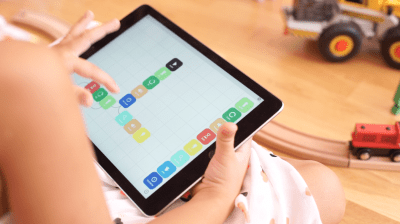
Robo Wunderkind is unique because children need not have any prior programming experience to get going. Furthermore, the cubes‘ magnet-free and secure connection system makes Robo Wunderkind stand out from the crowd. Robo Wunderkind’s innovative design has been turning heads in Europe, earning robotics award from Futurezone and the German robotics company Festo, as well as multiple startup awards.
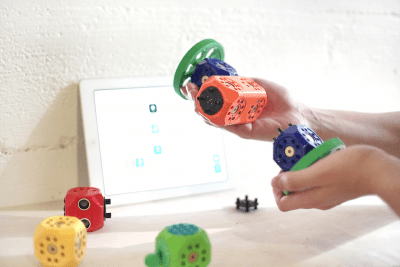
Robo Wunderkind comes in three sets. Kickstarter prices started at $79. There is a sliding price scale depending on the cube quantity and complexity. The cubes’ colors relate to their function: red is a proximity sensor, blue is a motor, orange – the main controller, and so on. The most advanced set comes with a digital camera and a weather sensor. With these special functions, your children can give weather forecasts or even surprise you with their first filming endeavors. Robo Wunderkind has been designed so that flat LEGOTM adaptors can be attached, making the blocks compatible with LEGOTM. Children can then personalize the robots they have built with LEGOTM blocks or figures.
Anna Iarotska, COO and Head of Business Development at Robo Technologies says, “Kickstarter is the perfect place to launch Robo Wunderkind, as it hosts a community of people who value innovation, creativity, and fun. We look forward to seeing what the kids out there will build with Robo Wunderkind”.
With their Kickstarter campaign, which will run until October 29, the team is hoping to raise $70,000. The funds they raise will go directly towards producing the very first batch of robots, with shipping scheduled for Summer 2016.
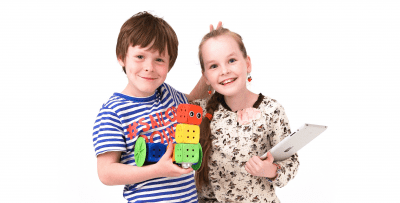
About Robo Technologies, Inc.
Rustem Akishbekov founded Robo Technologies, Inc and brought Anna Iarotska and Yuri Levin on board in 2013. The company is based in Vienna, Austria and San Francisco, California. The founders have gathered together a team of passionate engineers and designers who have been working on the project for two years.
In the summer of 2014, the team was part of the first worldwide hardware accelerator HAX. The progress made there was incorporated into Robo, earning them the „Robot of the Year“ Award from Festo and the Austrian Startup of the Year Award.
Unsatisfied by low cost, low precision and poor functionality desktop robotic arms on the market, a group of six hardcore robot makers decided to quit their high-paying industry jobs, and build their own. Named its first product Dobot, the team’s mission is to bring industrial precision to consumer, affordable robotic arms that can actually DO the job.
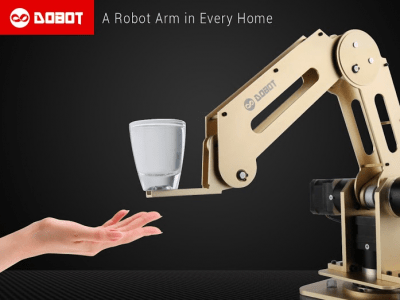
Fully designed and assembled in China, a new desktop, 4-axis, stepper motor, high precision robotic arm Dobot is launching its first Kickstarter campaign on September 15th, 2015 (Beijing Time).
The robot has tackled a series of technical difficulties struggled by other analogs. Here’s a list of its feature highlights:
For making it even more friendlier to both makers and the general public, Dobot’s design is well-fit for desktop applications, see its tech specifications:
The team has premiered its prototype at the 2015 Shenzhen Maker Faire, and has received positive feedback from makers, robot experts and open hardware communities ever since. “…the motion is really precise…it’s not just a toy, it can also be used to build stuff.” Says the CEO of Arduino, Massimo Banzi. On the popular DIY sharing platform Instrucables, its step-by-step instruction on building a robotic arm has received more than 23k likes in the first four days and got featured on the first page.
Upon their launch on Kickstarter, the team is very optimistic on the future performance of Dobot, marching their way to helping the world’s robot lovers to explore the beauty excitement of making stuff.
About the Team
The team was founded in June 2014 by a group of industrial robot engineers based in Shenzhen. The team’s CEO, Jerry (Peichao) Liu, and the head of engineering Art (Xulin) Lang both graduated from Shandong University in mechanics engineering. Jerry received its Masters from China Academy of Sciences, majoring in mechanics engineering and joined a robot company focusing on industrial robots for medical applications. Art during his Masters program, solely designed Delta parallel manipulator, Scara robot and a few others. After school, as the head of Scara robot project, he worked with Foxconn. All the founders all acquired extensive industry experience in robotics before joining the team. They have deep belief in bringing industrial precision robots to everyone’s desktop and in the future will launch a series of new models.
*Kickstarter launching on September 15, 2015 at
https://www.kickstarter.com/projects/neuronrobotics/wifi-dyio-robot-controller-w-24-channels
The WiFi DyIO (dynamic input and output device) is a wireless
micro-controller with 24 channels for robots, precision lasers, medical
equipment, 3D printers, motors, cameras, data sensors and more. With the
second generation WiFi DyIO, you can control all your devices with a
computer or Android phone—even with little programing knowledge. And
because WiFi DyIO simply coordinates the processors on your computer
wirelessly to your robot, it operates with JAVA programing language from
across the room, or around the globe.

The controller works seamlessly with Neuron Robotics Cooperative’s
<https://neuronrobotics.com> free, open-source
software, BowlerStudio, which allows the virtual design and testing of
different robotics systems and parts. There are powerful modeling tools for
adept programmers, as well as easy-to-use, customizable templates for
first-time designers. Features include coordination with 3D printers to
quickly and effortlessly print custom limbs, bodies and other parts.
The DyIO/BowlerStudio system is simple and intuitive for classroom lessons
with 8-year-olds, and powerful enough for a Ph.D robotics engineer. Its
software was used to perform surgery within an MRI
<http://spectrum.ieee.org/automaton/robotics/medical-robots/inside-an-mri-a-nonmetallic-robot-performs-prostate-surgery>
and the DyIO itself is used to teach classes at Worcester Polytechnic
Institute.
DyIO and BowlerStudio have been featured on 3DPrint.com, 3ders.org and is a
semifinalist for the Hackaday Prize.
The first generation, USB-connection DyIOs are available at Microcenters
throughout the U.S. and are being used in college and grade school
classrooms. In order to take the functional WiFi-enabled prototype into
production, Neuron Robotics Cooperative is looking to Kickstarter for
$35,000.
For the average person, the word drone likely brings one of several images to mind. One of those is the Unmanned Aerial Vehicles more commonly used by the military.
People with various levels of training and intelligence can now buy various versions of „copter“ drones, depending only on their budget. What logically follows are reports of people crashing their new toys (some costing $1,000 or more) into people or buildings, perhaps a testament to how little thought has gone into the idea.
Even Amazon is toying with the idea of using drones to deliver orders of laundry detergent or whatever it is that a conventional courier service can’t get to you fast enough before you run out.
The point is, when we think of drones, we typically think about one direction and that is up.
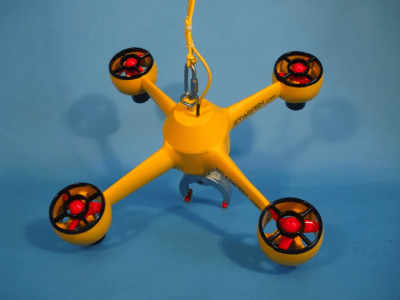
SheerTech, a Canadian industrial design company, is about to expand our directional thinking with a nifty little device that’s sure to be a hit with the underwater diving community.
It’s calling its invention the Starfish Underwater Quadradiver Robot and it won’t take you long to figure how this entirely capable device could quickly become an indispensable tool on a recreational dive boat (or any boat where fun and utility are the objective).
The Starfish—we’ll shorten the name from here on—connects its human operator on the surface with a 300-foot umbilical cord (which obviously defines how deep the device will go).
But as divers will already know, 300 feet is a long way down and there’s a good deal that can be done between the surface and that depth.
Connected to an IPad or Android device, the Starfish is naturally buoyant (which makes the surface set-up that much easier). The four 12-volt thruster motors are used to maneuver both downward and laterally and there’s a video camera as well as a maneuverable grappling hook capable of securing items weighing up to 500 pounds before the operator pulls the Starfish to the surface.
Mario Thibert, a master diver who once owned his own dive boat, is one who sees the potential of Starfish for the underwater diving community.
Writing on his website Thibert (http://www.crowdfunding-reviews.com) looked at Starfish from the diver’s perspective, and applauded the idea.
„This is not just a gadget for finding things at the bottom of the lake,“ writes Thibert. „This is a business.“
Thibert writes from experience, having owned a dive boat that operated on the St. Lawrence River, one of the busiest summer dive spots in the area off the province of Quebec, Canada.
„At the end of the day, we’d drive around in the boat near popular wrecks where there could be 150-200 divers on a weekend and we’d ‚drift‘ around where the boats would have been,“ Thibert writes. „People would drop things—a lot of stuff—when they were going down the moor line at a 45 degree angle and we’d pick up stuff like dive computers, BCDs, regulators, tanks, you name it.“
On the downside of that exercise, as divers well know, there’s a lot of work associated with just scouting around, not least of which is the need for a dive buddy.
With Starfish, trolling for treasure would become a lot easier—and potentially a lot more profitable.
Even at $2,000 per unit (the Kickstarter campaign runs until October 14) a dive community that’s accustomed to moderately hefty price tags will see the value.
Indeed, Thibert admits he paid $1,500 for a tethered camera alone.
„This is really an amazing product,“ he writes on his review site. „For a scuba diver, $2,000 is peanuts for something like this. There’s a lot of value here.“
The Starfish Underwater Quadradiver Robot is featured on Kickstarter (link https://www.kickstarter.com/projects/1066181261/starfish-underwater-quadradiver-robot).
OpenROV launches Trident, an all-new, low-cost underwater consumer drone. Part of an ongoing mission to democratize ocean exploration, this model is simple enough to “plug in and go,” and capable enough to use for scientific research and serious exploration. Orders can be placed on Kickstarter starting today, September 14, 2015.
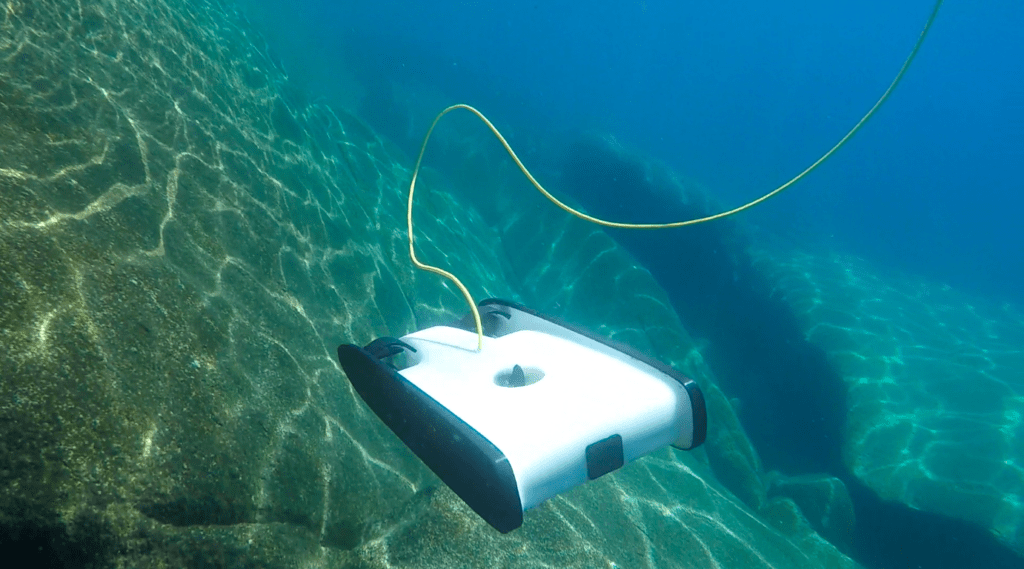
OpenROV has already established a rich community of makers, explorers, and ocean enthusiasts with its popular OpenROV kits. The company began in 2012 when co-founders Eric Stackpole and David Lang came up with the design for an expedition to find gold lost in an underwater cave. Noticing there weren’t any affordable underwater ROVs on the market, they realized that they were tapping into a burgeoning trend that enabled citizen explorers and scientists.
Writes David Lang about this movement towards accessible research tools, “The cost of asking interesting questions and then sharing those results with the wider world has been drastically reduced. New discoveries can come from anyone, and from anywhere.”
The first OpenROV Kickstarter project was a big success – making almost $100,000 more than their $20,000 goal. Since then they have grown significantly, shipping over 1,700 OpenROVs to more than 32 countries around the world.
The Trident underwater drone weighs less than 3kg, and is small enough to fit in a backpack or underneath an airplane seat. It can dive to 100m depth. It’s hydrodynamic shape allows it to move both quickly and precisely. Trident sends live video back to the surface by way of a thin, neutrally buoyant tether, and is controlled by a laptop, smartphone or tablet at the surface.
Potential applications for Trident are numerous, including: marine biology projects, dive site surveys, boat inspections, and underwater exploration.
Trident’s unique shape and design make it ideal for projects such as 3D mapping that require it to move along transects – long straight lines for surveying large areas. The HD video stream allows the pilot to view the underwater world in a way that has never before been possible, and Trident’s ease of operation makes flying the robot fun and exciting for anyone – regardless of technical skill. The OpenROV team has spent the past three years designing, testing, and developing Trident with the end user in mind. Expected delivery is November 2016.
At his TEDx talk earlier this year, co-founder Eric Stackpole remarked, “I like to picture a world where hundreds of thousands of people have access to these kinds of tools for exploration. What happens when you put this kind of ability to explore the world in the hands of everybody?”
Trident is a giant step in that direction.
More information: http://openrov.com
West Yorkshire technology firm, Matrix Technology Solutions are poised to launch their first ever Kickstarter campaign with a state of the art robot buggy and robotics course they are hoping to launch early next year.
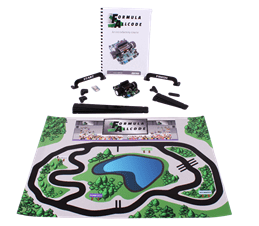
Formula AllCode as it is known, is a robotics course which includes a high spec, Bluetooth enabled robot compatible with Android, iOS, Windows and Raspberry Pi devices.
The project consists of:
Find out more here: https://www.kickstarter.com/projects/11644483/486244280?token=3567a2f2
Kickstarter is an online crowd funding website full of projects, big and small, that are brought to life through people’s direct support. Since launch in 2009, 9.1 million people have pledged more than $1.8 billion, funding 89,000 creative projects.
You can get behind the Formula AllCode Kickstarter and pledge your support when the project launches in early August. Keep an eye out at www.matrixtsl.com for more details.
Sudbury, Ontario, Canada – Local business, Clickmox Solutions, is pleased to announce the launch of its Kickstarter campaign for its new product: the Scan3D laser scanner. The campaign was launched on August 18th at 10:45am and will be active for 25 days – until September 12th.

Although 3D laser scanning is a mature technology, it is not yet widely available to the public, due mostly to its high cost. Scan3D is a lightweight and affordable large area laser scanner, which is locally manufactured at the Clickmox Solutions office in Sudbury. It is designed to tackle the need for an inexpensive, compact laser scanner that is versatile enough to meet any consumer need.
Scan3D offers real-time 3D mapping capabilities at a fraction of the price of its competitors. Mountable on aerial drones and ground vehicles, Scan3D has many industrial and recreational applications from obstacle avoidance to vehicle positioning and 3D mapping.
Clickmox Solutions is offering three different models of the Scan3D system, costing $1,195, $4,590, and $6,590. All three models include a software development kit, which allows consumers to adapt Scan3D to their specific applications. The Advanced and Ultimate models also include access to Clickmox’s SLAM Libraries and instructions on how to create 3D maps in real time.
Scan3D uses a 2D laser scanner, which it pivots on a servo motor. It combines these data with data from a positional sensor to generate 3D maps. This technology has already been used by Clickmox in the mining industry.
Kickstarter campaign: https://goo.gl/ZlZEfK
New York—July 9, 2015—Robotics and open source hardware provider DFRobot today announces their new interactive toy, the Vortex robot. Designed to teach, empower and entertain children in an interactive robotics environment, DFRobot today also launched its Kickstarter campaign to raise $50,000 for continued product development.
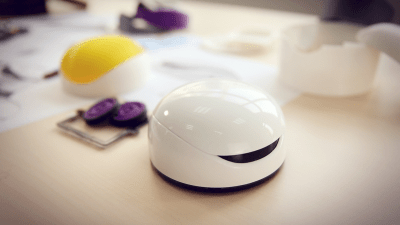
Combatting the trend of over-reliance on virtual games and screen time while transforming the robotic toy, DFRobot’s Vortex allows children to combine physical and virtual play. Children can interact with their toy robot while also programming and inventing their own commands and games, all via their smartphone or tablet.
Vortex has the following standout features:
“We’re transforming the household into part robotics lab, part playground,” said Ricky Ye, CEO, DFRobot. “We fully believe in the philosophy of learning through play. With our robot, which offers an immersive programming experience, children can learn to code while having genuine fun. Our mission is to bridge the gap between toys and education–particularly STEM education–as technology-driven skills are more important than ever.”
Vortex’s pre-programmed games are designed to be fun and intuitive. Bumping Fight serves as a pushing match between two players to force others from the arena, while Virtual Golf allows children to direct the robot towards a target, while controlling the power of their shots. In addition, Driving allows children to use their device as a remote control to drive their Vortex forward, backwards, right or left around a track, and with Robot Soccer, children can play a match with anywhere from 2-22 players.
DFRobot’s Vortex is suggested for children ages six and up. By supporting the Kickstarter campaign, backers can pre-order the Vortex robot two-pack for $119 with their contributions. Robots will ship to consumers in fall, 2015.
About DFRobot
DFRobot is a robotics and open source hardware provider that is dedicated to creating innovative, user-friendly products that foster a strong community of learning. DFRobot collaborates with multiple tech giants including Intel and Microsoft and has a product catalog boasting over 1,000 components and widgets including sensors, robotic platforms, communication modules and 3D printers. DFRobot is one of the early evangelists of the Maker Movement and strongly supports greater access to the maker culture.
DFRobot’s new product, Vortex is an intelligent and responsive robot that will enable children to learn, play and program. Vortex will bring together robotics with digital games through fun and interactive apps that allow children to explore, program their own games and solve problems.
DFRobot is headquartered in Shanghai, China. For more information visit www.dfrobot.com.